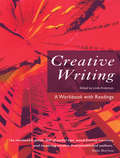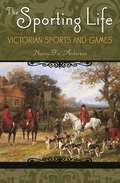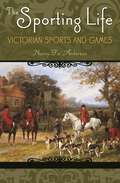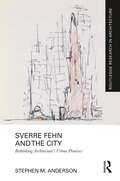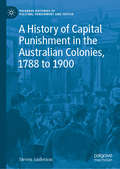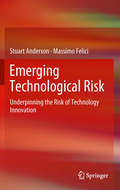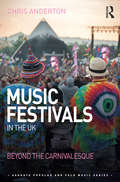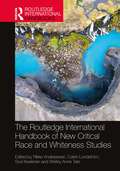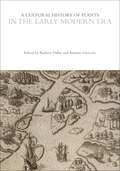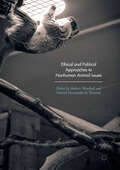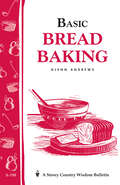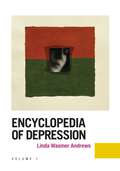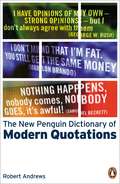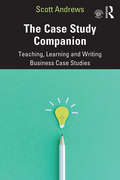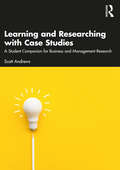- Table View
- List View
Design Energy Simulation for Architects: Guide to 3D Graphics
by Kjell AndersonLeading architectural firms are now using in-house design simulation to help make more sustainable design decisions. Taking advantage of these new tools requires understanding of what can be done with simulation, how to do it, and how to interpret the results. This software-agnostic book, which is intended for you to use as a professional architect, shows you how to reduce the energy use of all buildings using simulation for shading, daylighting, airflow, and energy modeling. Written by a practicing architect who specializes in design simulation, the book includes 30 case studies of net-zero buildings, as well as of projects with less lofty goals, to demonstrate how energy simulation has helped designers make early decisions. Within each case study, author Kjell Anderson mentions the software used, how the simulation was set up, and how the project team used the simulation to make design decisions. Chapters and case studies are written so that you learn general concepts without being tied to particular software. Each chapter builds on the theory from previous chapters, includes a summary of concept-level hand calculations (if applicable), and gives comprehensive explanations with graphic examples. Additional topics include simulation basics, comfort, climate analysis, a discussion on how simulation is integrated into some firms, and an overview of some popular design simulation software.
Creative Writing: A Workbook with Readings
by Linda AndersonCreative Writing is a complete writing course that will jump-start your writing and guide you through your first steps towards publication. Suitable for use by students, tutors, writers’ groups or writers working alone, this book offers: a practical and inspiring section on the creative process, showing you how to stimulate your creativity and use your memory and experience in inventive ways in-depth coverage of the most popular forms of writing, in extended sections on fiction, poetry and life writing, including biography and autobiography, giving you practice in all three forms so that you might discover and develop your particular strengths a sensible, up-to-date guide to going public, to help you to edit your work to a professional standard and to identify and approach suitable publishers a distinctive collection of exciting exercises, spread throughout the workbook to spark your imagination and increase your technical flexibility and control a substantial array of illuminating readings, bringing together extracts from contemporary and classic writings in order to demonstrate a range of techniques that you can use or adapt in your own work. Creative Writing: A Workbook with Readings presents a unique opportunity to benefit from the advice and experience of a team of published authors who have also taught successful writing courses at a wide range of institutions, helping large numbers of new writers to develop their talents as well as their abilities to evaluate and polish their work to professional standards. These institutions include Lancaster University and the University of East Anglia, renowned as consistent producers of published writers.
Creative Writing: A Workbook with Readings
by Linda AndersonCreative Writing is a complete writing course that will jump-start your writing and guide you through your first steps towards publication. Suitable for use by students, tutors, writers’ groups or writers working alone, this book offers: a practical and inspiring section on the creative process, showing you how to stimulate your creativity and use your memory and experience in inventive ways in-depth coverage of the most popular forms of writing, in extended sections on fiction, poetry and life writing, including biography and autobiography, giving you practice in all three forms so that you might discover and develop your particular strengths a sensible, up-to-date guide to going public, to help you to edit your work to a professional standard and to identify and approach suitable publishers a distinctive collection of exciting exercises, spread throughout the workbook to spark your imagination and increase your technical flexibility and control a substantial array of illuminating readings, bringing together extracts from contemporary and classic writings in order to demonstrate a range of techniques that you can use or adapt in your own work. Creative Writing: A Workbook with Readings presents a unique opportunity to benefit from the advice and experience of a team of published authors who have also taught successful writing courses at a wide range of institutions, helping large numbers of new writers to develop their talents as well as their abilities to evaluate and polish their work to professional standards. These institutions include Lancaster University and the University of East Anglia, renowned as consistent producers of published writers.
The Sporting Life: Victorian Sports and Games (Victorian Life and Times)
by Nancy Fix AndersonThis lively and intriguing study looks at the way sports both reflected and shaped Victorian society.Just as our own games have a lot to say about modern American culture, so sports are a prism through which we can gain valuable insights into Victorian society. The Sporting Life: Victorian Sports and Games is an engaging and perceptive account of how sport developed during Britain's heyday, who played (and who wasn't allowed to play), and what it all conveys about gender, race, imperialism, and national pride.Drawing extensively on 19th-century writings, The Sporting Life begins with a survey of sports in pre-Victorian England and the impact of industrialism in the early 19th century. We read of the effects of evangelicalism and utilitarianism, both of which first opposed sport, then used it for their own purposes. We learn of the association of sports with masculinity, an identification women challenged late in the century. Finally we learn how English sports became part of the imperial game, used to promote—and resist—the spread of Victoria's vast empire.
The Sporting Life: Victorian Sports and Games (Victorian Life and Times)
by Nancy Fix AndersonThis lively and intriguing study looks at the way sports both reflected and shaped Victorian society.Just as our own games have a lot to say about modern American culture, so sports are a prism through which we can gain valuable insights into Victorian society. The Sporting Life: Victorian Sports and Games is an engaging and perceptive account of how sport developed during Britain's heyday, who played (and who wasn't allowed to play), and what it all conveys about gender, race, imperialism, and national pride.Drawing extensively on 19th-century writings, The Sporting Life begins with a survey of sports in pre-Victorian England and the impact of industrialism in the early 19th century. We read of the effects of evangelicalism and utilitarianism, both of which first opposed sport, then used it for their own purposes. We learn of the association of sports with masculinity, an identification women challenged late in the century. Finally we learn how English sports became part of the imperial game, used to promote—and resist—the spread of Victoria's vast empire.
Sverre Fehn and the City: Rethinking Architecture’s Urban Premises (Routledge Research in Architecture)
by Stephen M. AndersonThe urban attentions of Pritzker Laureate Sverre Fehn (1924–2009) are extensive, but as yet virtually unexplored. This book examines ten select projects to illuminate Fehn’s approach to the city, the embodiment of that thinking in his designs, and the broader lessons those efforts offer for better understanding the relationship between architecture and urban life, with unignorable implications for emergent urban architecture and its address of sociological and ecological crises. Wary of large-scale planning proposals or the erasure of existing urban patterns, Fehn offered an uncommon and profoundly vibrant approach to urbanism at the scale of the single architectural project. His writings, constructed buildings, competition entries, and lectures suggest opportunities for reinvigorating architecture’s engagement with the city, and provoke a rethinking of concepts foundational to its theorization. What is the nature of urbanity? What is the relationship of urbanity to the natural world? What is the role of architecture in the provision and sustenance of urban life? While exploring this territory will expand our knowledge of an architect central to key developments of late modernism, the range of the book and the arguments developed therein delineate far broader aims: a fuller understanding of architecture’s urban promise.
Sverre Fehn and the City: Rethinking Architecture’s Urban Premises (Routledge Research in Architecture)
by Stephen M. AndersonThe urban attentions of Pritzker Laureate Sverre Fehn (1924–2009) are extensive, but as yet virtually unexplored. This book examines ten select projects to illuminate Fehn’s approach to the city, the embodiment of that thinking in his designs, and the broader lessons those efforts offer for better understanding the relationship between architecture and urban life, with unignorable implications for emergent urban architecture and its address of sociological and ecological crises. Wary of large-scale planning proposals or the erasure of existing urban patterns, Fehn offered an uncommon and profoundly vibrant approach to urbanism at the scale of the single architectural project. His writings, constructed buildings, competition entries, and lectures suggest opportunities for reinvigorating architecture’s engagement with the city, and provoke a rethinking of concepts foundational to its theorization. What is the nature of urbanity? What is the relationship of urbanity to the natural world? What is the role of architecture in the provision and sustenance of urban life? While exploring this territory will expand our knowledge of an architect central to key developments of late modernism, the range of the book and the arguments developed therein delineate far broader aims: a fuller understanding of architecture’s urban promise.
A History of Capital Punishment in the Australian Colonies, 1788 to 1900 (Palgrave Histories of Policing, Punishment and Justice)
by Steven AndersonThis book provides a comprehensive overview of capital punishment in the Australian colonies for the very first time. The author illuminates all aspects of the penalty, from shortcomings in execution technique, to the behaviour of the dying criminal, and the antics of the scaffold crowd. Mercy rates, execution numbers, and capital crimes are explored alongside the transition from public to private executions and the push to abolish the death penalty completely. Notions of culture and communication freely pollinate within a conceptual framework of penal change that explains the many transformations the death penalty underwent. A vast array of sources are assembled into one compelling argument that shows how the ‘lesson’ of the gallows was to be safeguarded, refined, and improved at all costs. This concise and engaging work will be a lasting resource for students, scholars, and general readers who want an in-depth understanding of a long feared punishment.Dr. Steven Anderson is a Visiting Research Fellow in the History Department at The University of Adelaide, Australia. His academic research explores the role of capital punishment in the Australian colonies by situating developments in these jurisdictions within global contexts and conceptual debates.
Immigration (Greenwood Guides to Business and Economics)
by Stuart AndersonImmigration is a comprehensive and practical guide to the history, economics, and contributions of immigrants, written by a former key policymaker who is now a leading researcher in the field.Immigration is a comprehensive examination of U.S. immigration policies and their impact on the nation, combining a historical overview and a guide to how immigration works in practice. In this one-volume compendium on the history, politics, culture, and contributions of immigrants to the United States, the author uses his experience in key immigration policy posts to provide an insider's perspective on a broad array of immigration-related issues.Offering a detached, unbiased analysis of the economic, fiscal, and other impacts of current immigration policies, he recommends reforms and policy solutions for the thorniest immigration issues, such as illegal immigration. But the book does not ignore the fact that immigration has always enriched and strengthened our nation. Along with policy considerations, it also encompasses enlightening profiles detailing the many contributions of individual immigrants in such diverse areas as science, sports, the military, and business.
Emerging Technological Risk: Underpinning the Risk of Technology Innovation
by Stuart Anderson Massimo FeliciClasses of socio-technical hazards allow a characterization of the risk in technology innovation and clarify the mechanisms underpinning emergent technological risk. Emerging Technological Risk provides an interdisciplinary account of risk in socio-technical systems including hazards which highlight:· How technological risk crosses organizational boundaries,· How technological trajectories and evolution develop from resolving tensions emerging between social aspects of organisations and technologies and· How social behaviour shapes, and is shaped by, technology.Addressing an audience from a range of academic and professional backgrounds, Emerging Technological Risk is a key source for those who wish to benefit from a detail and methodical exposure to multiple perspectives on technological risk. By providing a synthesis of recent work on risk that captures the complex mechanisms that characterize the emergence of risk in technology innovation, Emerging Technological Risk bridges contributions from many disciplines in order to sustain a fruitful debate. Emerging Technological Risk is one of a series of books developed by the Dependability Interdisciplinary Research Collaboration funded by the UK Engineering and Physical Sciences Research Council.
Music Festivals in the UK: Beyond the Carnivalesque (Ashgate Popular and Folk Music Series)
by Chris AndertonThe outdoor music festival market has developed and commercialised significantly since the mid-1990s, and is now a mainstream part of the British summertime leisure experience. The overall number of outdoor music festivals staged in the UK doubled between 2005 and 2011 to reach a peak of over 500 events. UK Music (2016) estimates that the sector attracts over 3.7 million attendances each year, and that music tourism as a whole sustains nearly 40,000 full-time jobs. Music Festivals in the UK is the first extended investigation into this commercialised rock and pop festival sector, and examines events of all sizes: from mega-events such as Glastonbury Festival, V Festival and the Reading and Leeds Festivals to ‘boutique’ events with maximum attendances as small as 250. In the past, research into festivals has typically focused either on their carnivalesque heritage or on developing managerial tools for the field of Events Management. Anderton moves beyond such perspectives to propose new ways of understanding and theorising the cultural, social and geographic importance of outdoor music festivals. He argues that changes in the sector since the mid-1990s, such as professionalisation, corporatisation, mediatisation, regulatory control, and sponsorship/branding, should not necessarily be regarded as a process of transgressive 'alternative culture’ being co-opted by commercial concerns; instead, such changes represent a reconfiguration of the sector in line with changes in society, and a broadening of the forms and meanings that may be associated with outdoor music events.
Music Festivals in the UK: Beyond the Carnivalesque (Ashgate Popular and Folk Music Series)
by Chris AndertonThe outdoor music festival market has developed and commercialised significantly since the mid-1990s, and is now a mainstream part of the British summertime leisure experience. The overall number of outdoor music festivals staged in the UK doubled between 2005 and 2011 to reach a peak of over 500 events. UK Music (2016) estimates that the sector attracts over 3.7 million attendances each year, and that music tourism as a whole sustains nearly 40,000 full-time jobs. Music Festivals in the UK is the first extended investigation into this commercialised rock and pop festival sector, and examines events of all sizes: from mega-events such as Glastonbury Festival, V Festival and the Reading and Leeds Festivals to ‘boutique’ events with maximum attendances as small as 250. In the past, research into festivals has typically focused either on their carnivalesque heritage or on developing managerial tools for the field of Events Management. Anderton moves beyond such perspectives to propose new ways of understanding and theorising the cultural, social and geographic importance of outdoor music festivals. He argues that changes in the sector since the mid-1990s, such as professionalisation, corporatisation, mediatisation, regulatory control, and sponsorship/branding, should not necessarily be regarded as a process of transgressive 'alternative culture’ being co-opted by commercial concerns; instead, such changes represent a reconfiguration of the sector in line with changes in society, and a broadening of the forms and meanings that may be associated with outdoor music events.
Individuals, Essence and Identity: Themes of Analytic Metaphysics (Topoi Library #4)
by Andrea Bottani, Massimiliano Carrara and Pierdaniele GiarettaAndrea Bottani Massimiliano Carrara Pierdaniele Giaretta What do we do when we do metaphysics? The aim of this introduction is to give a provisional answer to this question, and then to explain the subtitle of the volume. It is easy to observe that when we do meta physics we engage in a linguistic activity, mainly consisting of uttering declarative sentences that are not very clear to most people. That is true, but, of course, it is not very informative. What do we speak of when we do metaphysics? A traditional answer could be: we speak of what things really are, so suggesting that things can appear in a way that is different from the way they really are. So understood, meta physics is about the sense, or the senses, of "real being". A question that immediately arises is whether the sense of being is unique or is different for different types of things. Another question is whether it is possible that something could appear to be, but really not be. Modem analytic metaphysicians usually answer that the sense of being is unique, while acknowledging that there are different kinds of things, and that to say that something could appear to be but really not be is a plain contradiction, unless what is understood is that it could appear to us that there is something having such and such features, but viii Individuals, Essence, and Identity really there is no such a thing.
The Routledge International Handbook of New Critical Race and Whiteness Studies (Routledge International Handbooks)
by Rikke Andreassen Catrin Lundström Suvi Keskinen Shirley Anne TateSince its foundation as an academic field in the 1990s, critical race theory has developed enormously and has, among others, been supplemented by and (dis)integrated with critical whiteness studies. At the same time, the field has moved beyond its origins in Anglo-Saxon environments, to be taken up and re-developed in various parts of the world – leading to not only new empirical material but also new theoretical perspectives and analytical approaches. Gathering these new and global perspectives, this book presents a much-needed collection of the various forms, sophisticated theoretical developments and nuanced analyses that the field of critical race and whiteness theories and studies offers today. Organized around the themes of emotions, technologies, consumption, institutions, crisis, identities and on the margin, this presentation of critical race and whiteness theories and studies in its true interdisciplinary and international form provides the latest empirical and theoretical research, as well as new analytical approaches. Illustrating the strength of the field and embodying its future research directions, The Routledge International Handbook of New Critical Race and Whiteness Studies will appeal to scholars across the social sciences and humanities with interests in race and whiteness.
Wittgenstein and Interreligious Disagreement: A Philosophical and Theological Perspective
by Gorazd AndrejčThis book critically examines three distinct interpretations of Ludwig Wittgenstein, those of George Lindbeck, David Tracy, and David Burrell, while paying special attention to the topic of interreligious disagreement. In theological and philosophical work on interreligious communication, Ludwig Wittgenstein has been interpreted in very different, sometimes contradicting ways. This is partly due to the nature of Wittgenstein’s philosophical investigation, which does not consist of a theory nor does it posit theses about religion, but includes several, varying conceptions of religion. In this volume, Gorazd Andrejč illustrates how assorted uptakes of Wittgenstein’s conceptions of religion, and the differing theological perspectives of the authors who formulated them, shape interpretations of interreligious disagreement and dialogue. Inspired by selected perspectives from Tillichian philosophical theology, the book suggests a new way of engaging both descriptive and normative aspects of Wittgenstein’s conceptions of religion in the interpretation of interreligious disagreement.
A Cultural History of Plants in the Early Modern Era (The Cultural Histories Series)
by Andrew Dalby and Annette GieseckeA Cultural History of Plants in the Early Modern Era covers the period from 1400 to 1650, a time of discovery and rediscovery, of experiment and innovation. Renaissance learning brought ancient knowledge to modern European consciousness whilst exploration placed all the continents in contact with one another. The dissemination of knowledge was further speeded by the spread of printing. New staples and spices, new botanical medicines, and new garden plants all catalysed agriculture, trade, and science. The great medical botanists of the period attempted no less than what Marlowe's Dr Faustus demanded - a book “wherein I might see all plants, herbs, and trees that grow upon the earth.” Human impact on plants and our botanical knowledge had irrevocably changed. The 6 volume set of the Cultural History of Plants presents the first comprehensive history of the uses and meanings of plants from prehistory to today. The themes covered in each volume are plants as staple foods; plants as luxury foods; trade and exploration; plant technology and science; plants and medicine; plants in culture; plants as natural ornaments; the representation of plants. Andrew Dalby is an independent scholar and writer, based in France. Annette Giesecke is Professor of Classics at the University of Delaware, USA. Volume 3 in the Cultural History of Plants set.General Editors: Annette Giesecke, University of Delaware, USA, and David Mabberley, University of Oxford, UK.
Ethical and Political Approaches to Nonhuman Animal Issues
by Andrew Woodhall and Gabriel Garmendia da TrindadeThis book offers ethical and political approaches to issues that nonhuman animals face. The recent ‘political turn’ in interspecies ethics, from ethical to political approaches, has arisen due to the apparent lack of success of the nonhuman animal movement and dissatisfaction with traditional approaches. Current works largely present general positions rather than address specific issues and principally rely on mainstream approaches. This book offers alternative positions such as cosmopolitan, libertarian, and left humanist thought, as well as applying ethical and political thought to specific issues, such as experimentation, factory farming, nonhuman political agency, and intervention. Presenting work by theorists and activists, insights are offered from both ethics and politics that impact theory and practice and offer essential considerations for those engaging in interspecies ethics within the political turn era.
Basic Bread Baking: Storey's Country Wisdom Bulletin A-198 (Storey Country Wisdom Bulletin)
by Glenn AndrewsSince 1973, Storey's Country Wisdom Bulletins have offered practical, hands-on instructions designed to help readers master dozens of country living skills quickly and easily. There are now more than 170 titles in this series, and their remarkable popularity reflects the common desire of country and city dwellers alike to cultivate personal independence in everyday life.
Encyclopedia of Depression [2 volumes]: [2 volumes]
by Linda Wasmer AndrewsWritten in clear, nontechnical language, and filled with lively historical and cultural highlights, this comprehensive reference work is a scientifically grounded yet thoroughly readable introduction to depressive disorders.What distinguishes normal everyday emotional swings from debilitating, clinically identified depression? What are the defining symptoms, manifestations, and treatments? What is life like for people suffering from depression and for those who care for them? The Encyclopedia of Depression is for all those needing answers to questions like these—individuals, families, health professionals, or anyone fascinated by this pervasive condition.Written in clear, nontechnical language and highlighting fascinating historical and cultural perspectives on the topic, this two-volume resource presents a complete contemporary portrait of depressive disorders, summarizing the latest scientific, medical, and societal thinking on a wide variety of depression-related topics. Coverage includes causes, risk factors, symptoms, diagnosis and prevention, and a wide range of treatment options, including psychotherapy, medication, biological treatments, alternative therapies and lifestyle approaches. In addition, the encyclopedia discusses historical and cross cultural perspectives on the condition, including the dramatic shifts in public awareness and cultural attitudes toward the disease and the devastation it can cause.
Langford's Starting Photography: The Guide to Creating Great Images
by Philip AndrewsStarting with the basics of camera control and moving on to shutter speeds, aperture, zoom and flash, Langford’s Starting Photography gives you the only introduction to digital photography you’ll ever need. Once you’ve mastered the basics, examples and projects allow you to explore the key methods for capturing a variety of subjects from portraits and pets to landscapes and sports photography, alongside straightforward advice on using editing software to get the best out of your digital shots, will have you producing unforgettable images in moments. More inspiring than a textbook, more interesting than a reference, and more in-depth than a photography class, Langford’s Starting Photography is the only guide you need to start taking great images.
Langford's Starting Photography: The Guide to Creating Great Images
by Philip AndrewsStarting with the basics of camera control and moving on to shutter speeds, aperture, zoom and flash, Langford’s Starting Photography gives you the only introduction to digital photography you’ll ever need. Once you’ve mastered the basics, examples and projects allow you to explore the key methods for capturing a variety of subjects from portraits and pets to landscapes and sports photography, alongside straightforward advice on using editing software to get the best out of your digital shots, will have you producing unforgettable images in moments. More inspiring than a textbook, more interesting than a reference, and more in-depth than a photography class, Langford’s Starting Photography is the only guide you need to start taking great images.
The New Penguin Dictionary of Modern Quotations (Penguin Reference Bks.)
by Robert AndrewsThe New Penguin Dictionary of Modern Quotations contains over 8,000 quotations from 1914 to the present. As much a companion to the modern age as it is an entertaining and useful reference tool, it takes the reader on a tour of the wit and wisdom of the great and the good, from Margot Asquith to Monica Lewinsky, from George V to Boutros Boutros-Galli and Jonathan Aitken to Frank Zappa.
The Case Study Companion: Teaching, Learning and Writing Business Case Studies
by Scott AndrewsThe Case Study method of teaching and learning, adopted by business schools and management centres globally, provides an important function in management education, but employing it effectively can often be a challenge. This book provides practical insights, tools and approaches for both case teaching and writing, drawing on perspectives from expert practitioners around the world. This book aims to critically examine different approaches to using case studies in group-based, participant-centred learning environments, exploring good practices for case teaching and learning. It provides guidance for case writers on various approaches to structuring case data, presentational formats, and the use of technology in the construction of different types of cases. It also demonstrates the use of the case method as a tool for assessment, supporting students’ own development of cases to showcase good practice in organisations. The final section of this book showcases some of the resources available, providing links and reviews of additional material that can support future case teaching and writing practice, including publication. The Case Study Companion is designed for lecturers using cases within their teaching across all management disciplines, as well as those training for Professional Development and Management Education qualifications. It will also be useful for postgraduate, MBA and Executive Education students wanting to make the most of case studies in their learning and assessments.
The Case Study Companion: Teaching, Learning and Writing Business Case Studies
by Scott AndrewsThe Case Study method of teaching and learning, adopted by business schools and management centres globally, provides an important function in management education, but employing it effectively can often be a challenge. This book provides practical insights, tools and approaches for both case teaching and writing, drawing on perspectives from expert practitioners around the world. This book aims to critically examine different approaches to using case studies in group-based, participant-centred learning environments, exploring good practices for case teaching and learning. It provides guidance for case writers on various approaches to structuring case data, presentational formats, and the use of technology in the construction of different types of cases. It also demonstrates the use of the case method as a tool for assessment, supporting students’ own development of cases to showcase good practice in organisations. The final section of this book showcases some of the resources available, providing links and reviews of additional material that can support future case teaching and writing practice, including publication. The Case Study Companion is designed for lecturers using cases within their teaching across all management disciplines, as well as those training for Professional Development and Management Education qualifications. It will also be useful for postgraduate, MBA and Executive Education students wanting to make the most of case studies in their learning and assessments.
Learning and Researching with Case Studies: A Student Companion for Business and Management Research
by Scott AndrewsThis companion takes the student through the different approaches to working with cases in the classroom, virtually and for research purposes. Capturing insights and best practices shared by scholars of the case method from around the world, this book aims to:• equip students to work with and analyse case studies as part of their programme of study;• adapt student approaches to online learning with cases;• guide students on how to use case studies as a form of assessment;• help students looking to adopt a case study approach to a research project.These aims are framed in the sections of the book. Each section contains reflections from academics across the world, personal insights and lessons learnt from case sessions, templates, and exercises to develop your own skills in learning or researching with cases. Full examples showcase the nature of cases by type and format: short incident, exercise case, situation case; single, sequential and digital cases.This text is for undergraduate and postgraduate Business and Management students, those studying as part of executive education programmes, MBA students, and academics who are using or preparing to use case studies in their learning or research. Online resources include PowerPoint slides, video material and example case studies from around the world.

